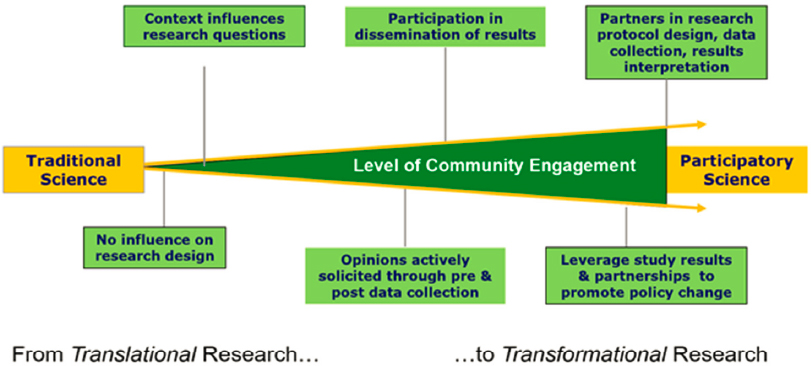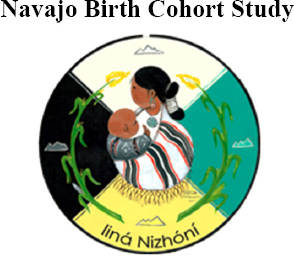Appendix E
Participatory Research Approaches
HISTORICAL ASPECTS
The history of participatory research methods is connected to the environmental justice movement, which arose as a fusion of Indigenous environmental rights, the civil rights movement, environmentalism, and public health protection in response to environmental racism. The vision was to eliminate inequalities in economic opportunity, environmental exposures, and health outcomes. This movement has been instrumental in empowering communities that are underprivileged, populations of color, Indigenous populations, and the poor, bringing attention to the environmental hazards that burden their communities.
In April 1990, the Congressional Black Caucus met with U.S. Environmental Protection Agency (EPA) officials to discuss their findings that environmental risk was higher for minority and low-income populations. In response, EPA created the Environmental Equity Workgroup in July 1990. In 1994, the Environmental Justice Small Grants program was established to provide financial assistance to eligible organizations to build collaborative partnerships and to empower communities through education, training, and outreach.1 In 2004, EPA’s Office of Environmental Justice developed the “Toolkit for Assessing Potential Allegations of Environmental Injustice,” a systematic approach to assess and respond to potential allegations of environmental injustice as they occur and to prevent environmental injustices.2 In June 2015, EPA shared with the public the initial version of EJScreen, a web-based screening and mapping tool developed as a nationally consistent approach and datasets for environmental justice. The EJScreen is a successful tool, widely used by scientists, governmental organizations, and communities and the public (EPA, 2022a). In 2016, the National Advisory Council for Environmental Policy and Technology released its report Environmental Protection Belongs to the Public: A Vision for Citizen Science at EPA. The report recommended that EPA
- Embrace citizen science as a core tenet of environmental protection;
- Invest in citizen science for communities, partners, and the agency;
- Enable the use of citizen science data at the agency; and
- Integrate citizen science into the full range of work of EPA (NACEPT, 2016).
EPA has implemented components of these recommendations through its citizen science program which supports environmental monitoring, developed collaborations with communities addressing environmental justice concerns, and initiatives with states and sovereign tribal nations (EPA, 2022b).
EXAMPLES OF PARTICIPATORY RESEARCH APPLICATIONS
In 2022, participatory research methods and the environmental justice movement came to the central stage in environmental health sciences, with the recognition that community input and engagement are essential to address the major environmental injustice challenges affecting our society.
Scientists can undertake different levels of community engagement in the research process as shown in Figure E-1. On the left side, traditional scientific endeavors may collect community information or data, but treat community members as study participants only. Moving toward the right of this continuum, community members transition from being mere study participants to being active research partners, collaborating in the scientific work and turning discovery to action. Even on the right end of the continuum, however, the extent of community participation varies.
___________________
1 See https://www.epa.gov/environmentaljustice/environmental-justice-small-grants-program.
2 See https://www.epa.gov/sites/default/files/2015-02/documents/ej-toolkit.pdf.

As EPA continues to embrace participatory research, communities that are gaining access to emerging technologies and developing mechanisms, protocols, and data validation tools can illustrate ways in which the Office of Research and Development (ORD) can harness the energy and talents of these communities. There are numerous examples of how participatory research methods contribute to advancing EPA’s mission. Several examples are provided below.

The Strong Heart Study is a population-based study of cardiovascular disease and its risk factors ongoing in American Indian communities in the Southwest and the Great Plains since 1988.3 It was the first population-based study in a U.S. population of the long-term health effects of arsenic exposure in adults with a focus on cardiometabolic disease. From the start, the Strong Heart Study used a participatory approach building partnerships between the participating tribal nations, the academic institutions involved, and the National Institutes of Health (NIH), with support from the Indian Health Service. The study also invested in building the capacity to ensure that community members were actively engaged and were able to lead the research process. The role of environmental exposures as potential risk factors for cardiovascular disease became an important issue around 2006, coinciding with the implementation of EPA’s Arsenic Rule4 and concerns that American Indian communities had regarding disproportionate arsenic exposure from contaminated drinking water in their communities. The confirmation that arsenic is a risk factor for cardiovascular disease and other health outcomes has important implications for ongoing arsenic risk assessment and has motivated local interventions to mitigate arsenic exposure in community members that
___________________
3 See https://strongheartstudy.org.
4 See https://www.epa.gov/dwreginfo/chemical-contaminant-rules.
remain affected by contaminated private wells. Beyond arsenic, the Strong Heart Study has investigated other environmental exposures, in particular metals, and in more recent years there is an interest in air pollution, for which relatively little is known regarding the health effects for rural and Indigenous communities in the United States.

The Navajo Birth Cohort Study (NBCS) is another example of long-standing partnership between the Navajo Nation, academic institutions, and the Centers for Disease Control and Prevention and NIH.5 The NBCS is a prospective study of pregnancy and neonatal outcomes in a uranium-exposed population. The goal is to understand the relationship between uranium exposures and birth outcomes and childhood development in the Navajo Nation. This is a unique, important study that addresses a major environmental disaster ongoing for decades related to abandoned uranium mines and disproportionate metal mixture exposures affecting Indigenous communities, particularly in the Southwest and the Northern Plains. The NBCS is now part of the Environmental Influences on Child Health Outcomes program, an NIH program investigating how environmental and social stressors and lifestyles affect health outcomes in children.
Do-It-Yourself Biology
Do-it-yourself biology, or DIYbio, is a global movement spreading the use of biotechnology and synthetic biology tools to other communities beyond academic and industrial institutions (Grushkin et al., 2007). Participants include amateurs, students, and academically trained scientists, who use the technology and knowledge for activities, such as creating art, studying biology, and establishing new companies. DIYbio began to gather momentum around 2000, after a working draft of the human genome was completed by the Human Genome Project (Grushkin et al., 2007). People began setting up home laboratories, which evolved into dedicated laboratories in commercial spaces (Carlson, 2005). Organizers pooled resources to buy, or take donations of, equipment, and began what have become known as “community labs.” The first community lab opened in the United States in 2010.
These labs sustain themselves through volunteers, membership donations or dues, and paid classes. Since the late 2000s, the DIYbio movement has grown into a global research and innovation community in 25 countries. Currently, there are about 50 active laboratories that are a part of the DIYbio movement. Most operate under the community lab model, where the goal is to support local community education and experimentation in the biological sciences through the facilitation of independent and collaborative projects and classes that are open to the public. In addition, multiple startups, community groups, and incubator spaces identify as practicing DIYbio.6
A recent evolution of the DIYbio community is Just One Giant Lab (JOGL). This web-based platform provides a virtual “laboratory” network of DIYbio practitioners in “order to catalyze the collective creation of knowledge and solutions to resolve humanity’s most urgent challenges.”7 It includes more than
___________________
5 See https://hsc.unm.edu/pharmacy/research/areas/nbcs-echo.html.
6 See https://sphere.diybio.org.
7 See https://jogl.io.
5,500 members globally, working on roughly 330 projects. On March 1, 2020, JOGL launched the OpenCOVID19 Initiative with the goal of collectively developing “open-source and low-cost tools and methodologies that are safe and easy to use to fight the COVID-19 pandemic.”8 The initiative involves five separate challenge areas: Diagnostic, Validation, Treatment, Prevention, and Data. Many of these projects are being supported with microgrants provided by the AXA Research Fund (Rasmussen et al., 2020).
To address safety, security, and ethical concerns, the DIYbio community has developed a certified biosafety training course (Lim, 2008), in partnership with ABSA International and an open-access biosafety handbook developed specifically for the DIYbio community and its unique settings and needs (Genspace, 2020).
Rasmussen et al. (2020) suggests that non-establishment research faces a legitimacy challenge that could prevent broad implementation of its data collection, analysis, or applications. Federal regulations and formal training were built to help ensure the reliability and validity of scientific outcomes and public trust in institutional research. Because non-establishment research exists outside this framework, if it is to make significant contributions then it will need an equivalent legitimization in the eyes of regulators and the public (Rasmussen et al., 2020).
REFERENCES
Balazs, C. L., and R. Morello-Frosch. 2013. The three Rs: How community-based participatory research strengthens the rigor, relevance, and reach of science. Environmental Justice 6(1):9-16. http://doi.org/10.1089/env.2012.0017.
Carlson, R. 2005. Splice it yourself. Wired. https://www.wired.com/2005/05/splice-it-yourself.
EPA (U.S. Environmental Protection Agency). 2022a. EPA Launches Updates to Environmental Justice Mapping Tool EJScreen. https://www.epa.gov/newsreleases/epa-launches-updates-environmental-justice-mapping-tool-ejscreen.
EPA. 2022b. Participatory Science at EPA: Engaging the Public in Environmental Protection. https://storymaps.arcgis.com/stories/57b2ee78221341a18b0f7ebe8017340d.
Genspace. 2020. Community Biology Biosafety Handbook. https://www.genspace.org/community-biology-biosafety-handbook.
Grushkin, D., T. Kuiken, and P. Millet. 2007. Seven Myths and Realities About Do-It-Yourself Biology. Synthetic Biology Project. Wilson Center. https://www.wilsoncenter.org/publication/seven-myths-and-realities-about-do-it-yourself-biology-0.
Lim, Y. B. 2008. Checking Ourselves Before Wrecking Ourselves: Co-Evolving Innovation and Safety in the DIYBio Community. Baltimore Underground Science Space. https://bugssonline.org/community/diybio-biosafety.
NACEPT (National Advisory Council for Environmental Policy and Technology). 2016. Environmental Protection Belongs to the Public: A Vision for Citizen Science at EPA. https://www.epa.gov/sites/default/files/2020-04/documents/nacept_cs_report_final_508.pdf.
Rasmussen, L. M., C. J. Guerrini, T. Kuiken, C. Nebeker, A. Pearlman, S. B. Ware, A. Wexler, and P. J. Zettler. 2020. Realizing present and future promise of DIY biology and medicine through a trust architecture. Hastings Center Report 50(6):10-14. https://doi.org/10.1002/hast.1194.
___________________




